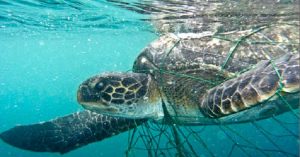Introduction
- Don’t tell your class the topic of the lesson.
- Show the 3 pictures below to your students. Ask them to work in pairs. Tell them to find a connection between the 3 pictures.
- Invite a few pairs to explain what they think the connection is and accept all answers.
- Say that Picture b) shows pieces of tuna, Picture a) shows a turtle caught in a net and Picture c) shows fishermen catching tuna with poles and lines.
- Explain that the topic of the lesson is World Tuna Day which is remembered each year on May 2nd. Ask students why they think it’s important to remember tuna. Suggest that this celebration by the United Nations is an important step in recognising the important role of tuna to sustainable development, food security, economic opportunity and the incomes of people around the world.
- Write the following questions on the board
- Do you like eating tuna?
- Would you be sad if you never ate tuna again?
- What can we do to stop tuna fish disappearing from our oceans?
- What do you know about the organisation Greenpeace?
- Ask students to discuss their answers in groups of 4. Nominate one student in each group to be the reporter. He/she should write down the main points discussed by the group.
- Take feedback from the reporters in each group. If the class doesn’t know anything about Greenpeace, explain that it an independent organisation, which uses non-violent methods to show environmental problems, and to force governments to find solutions which are essential to a green and peaceful future.
Jigsaw listening task
- Tell students that they are going to divide into two groups. Each group will watch a different video about tuna fishing. Write the following key vocabulary on the board:
|
the Maldives to benefit s/o or sth to breed a vessel massive to haul in a net to decline vulnerable an activist to wipe away the future |
- Explain the meaning of these words/phrases and model the pronunciation of each.
- Divide students into two groups. Tell Group A they are going to watch a Greenpeace video about sustainable fishing: youtube.com/watch?v=KxrCjWjqqME
- Tell Group B they are going to watch a Greenpeace video about stopping the world’s largest tuna boat from catching fish www.youtube.com/watch?v=BA7enHKa5As
- Tell groups that they should watch their video clip and write down 3 questions for the other group to answer.
- Give each group 10 minutes to watch their clip (on their smartphones or tablets) and write down their questions.
- Invite students to make new groups – 2 students from Group A work with 2 students from Group B. Give groups 10 minutes to watch each other’s clips and answer the 3 questions.
- Watch the 2 clips as a class and check the answers to the questions. Pick up any other vocabulary items that students ask about. E.g. to deplete the (fish) stock/to plunder.
Follow-up task
- Ask students to choose one of the tasks below:
- Write an email to your local supermarket explaining why it’s important to sell only pole and line caught tuna
- Role play a conversation between a Greenpeace activist and the captain of the Albertan Tres fishing vessel
- Organise a class debate on the topic: Tuna fishing is an important source of income for many poor people and should not be stopped
- Plan a campaign to raise awareness amongst other students about the problems of overfishing
- Plan a fun event to fundraise for Greenpeace
This unit was created by Julietta Schoenmann, GISIG Joint-Coordinator.



